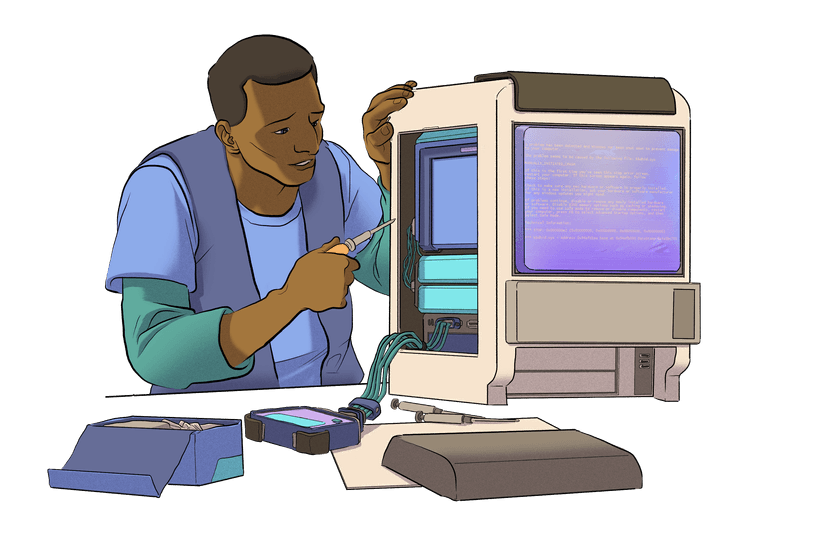Uyda tikish nima?
Uyda tikish bu Internetga ulangan Ethereum tugunini ishga tushirish va validatorni faollashtirish uchun 32 ETH depozit qilish harakati bo‘lib, sizga tarmoq konsensusida bevosita ishtirok etish imkoniyatini beradi.
Uyda tikish Ethereum tarmog‘ining nomarkazlashuvini kuchaytiradi, Ethereumni senzuraga chidamli va hujumlarga bardoshli qiladi. Boshqa staking usullari tarmoqqa bir xil tarzda yordam bermasligi mumkin. Uy tikish Ethereumni himoyalash uchun eng yaxshi staking usulidir.
Ethereum tuguni ham ijro qatlami (EL) mijozidan, ham konsensus qatlami (CL) mijozidan iborat. Bu mijozlar bitimlar va bloklarni tekshirish, zanjirning to‘g‘ri rahbarini tasdiqlash, jamlangan attestatlar va bloklarni taklif qilish uchun amaldagi imzolash kalitlari to‘plami bilan birga ishlaydigan dasturiy ta’minotdir.
Uyda tikuvchilar ushbu mijozlarni ishga tushirish uchun zarur bo‘lgan uskunalarni ishlatish uchun javobgardir. Buning uchun uyda ishlaydigan maxsus mashinadan foydalanish tavsiya etiladi — bu tarmoqning sogʻlomligi uchun juda foydali.
Uyda tikuvchi o‘z validatorining to‘g‘ri ishlashi va onlaynligi uchun to‘g‘ridan-to‘g‘ri protokoldan mukofotlar oladi.
Nega uyda tikish kerak?
Uyda tikish ko‘proq mas’uliyatni o‘z ichiga oladi, lekin sizga mablag‘laringiz va tikishni sozlash ustidan maksimal nazoratni ta’minlaydi.
Yangi ETH ishlab oling
Earn ETH-denominated rewards directly from the protocol when your validator is online, without any middlemen taking a cut.
Toʻliq nazorat
Keep your own keys. Choose the combination of clients and hardware that allows you to minimize your risk and best contribute to the health and security of the network. Third-party staking services make these decisions for you, and they don't always make the safest choices.
To‘liq nazorat
Home staking is the most impactful way to stake. By running a validator on your own hardware at home, you strengthen the robustness, decentralization, and security of the Ethereum protocol.
Uyda tikishdan oldingi mulohazalar
Biz uyda tikish hamma uchun qulay va risksiz bo‘lishini xohlasak-da, bu haqiqat emas. ETHingizni uyda tikishdan oldin yodda tutishingiz kerak bo‘lgan ba’zi amaliy va jiddiy mulohazalar mavjud.
Boshqa variantlar bilan solishtirish
Staking as a service (SaaS)
SaaS provayderlari bilan siz hali ham 32 ETH depozit qilishingiz kerak, lekin apparat jihozlarini ishga tushirishingiz shart emas. Odatda siz validator kalitlaringizga kirishni ta’minlaysiz, lekin operator validatoringiz nomidan harakat qilishi uchun imzolash kalitlaringizni ham ulashishingiz kerak. Bu o‘z uskunangizni ishlatishda mavjud bo‘lmagan ishonch qatlamini taqdim etadi va uyda yakka tartibda tikishdan farqli o‘laroq, SaaS tugunlarning geografik tarqalishiga unchalik yordam bermaydi. Agar operatsion uskunani ishlatish noqulay bo‘lsa-da, lekin hali ham 32 ETH tikishni istasangiz, SaaS provayderidan foydalanish siz uchun yaxshi tanlov bo‘lishi mumkin.
Xizmat sifatida steyking haqida batafsilBirlashtirilgan staking
Yakka tartibda pul tikish jamlash xizmati bilan pul tikishdan ko‘ra ko‘proq narsani o‘z ichiga oladi, lekin ETH mukofotlaridan to‘liq foydalanish va validatorni sozlash va xavfsizligini to‘liq nazorat qilishni taklif qiladi. Hovuzda qo‘yish kirish uchun sezilarli darajada past to‘siqqa ega. Foydalanuvchilar kichik miqdordagi ETH tikishlari mumkin, validator kalitlarini yaratish talab qilinmaydi va standart internet aloqasidan tashqari hech qanday apparat qismiga talablar yo‘q. Likvidli tokenlar protokol darajasida yoqilishidan oldin stavkadan chiqish imkoniyatini beradi. Agar sizga ushbu funksiyalar qiziqarli bo‘lsa, umumiy steyking yaxshi mos kelishi mumkin.
Birlashtirilgan steyking haqida batafsilBu qanday ishlaydi
Uskunani oling: Qatnashish uchun tugunni ishga tushirish kerak
Ijro qatlami mijozini sinxronlash
Konsensus qatlami mijozini sinxronlash
Kalitlaringizni yarating va ularni validator mijozingizga yuklang
Tuguningizni nazorat qilish va saqlash

Faolligida ETH mukofotlarini ishlab olasiz, ular vaqti-vaqti bilan yechib olish manzilingizga depozit qilinadi.
Agar istasangiz, onlayn bo‘lish shartini bekor qiladigan va boshqa mukofotlarni to‘xtatadigan tasdiqlovchi sifatida chiqishingiz mumkin. Keyin qolgan balansingiz sozlash paytida siz belgilagan yechib olish manziliga yechib olinadi.
Staking yechib olish haqida batafsil
Staking Launchpadda ishni boshlang
Staking Launchpad ochiq kodli ilova bo‘lib, sizga staker bo‘lishga yordam beradi. U mijozlaringizni tanlashda, kalitlaringizni yaratishda va ETHingizni garovga qo‘yish depozit shartnomasiga kiritishda sizga yordam beradi. Validatoringizni xavfsiz sozlash uchun hamma narsani qamrab olganingizga ishonch hosil qilish uchun nazorat ro‘yxati taqdim etiladi.
Yakka validatorlar mablag‘larni xavf ostiga qo‘yishdan oldin Hoodi test tarmog‘ida o‘z sozlamalarini va ishlash ko‘nikmalarini sinab ko‘rishlari kutilmoqda. Shuni yodda tutingki, minority clientni tanlash muhim, chunki bu tarmoq xavfsizligini yaxshilaydi va xavf-xataringizni cheklaydi.
Agar qulay bo‘lsa, faqat Staking Launchpad yordamida buyruq satridan kerakli hamma narsani sozlashingiz mumkin.
Ishni osonlashtirish uchun quyida Staking Launchpad bilan bir qatorda mijozlaringizni oson sozlashingizga yordam beradigan ba’zi vositalar va qo‘llanmalar bilan tanishing.
Tugun va mijozni sozlash vositalari bilan nimalarni hisobga olish kerak
ETHingizni uyda tikishga yordam beradigan vositalar va xizmatlar soni ortib bormoqda, ammo ularning har biri turli risk va foydalarga ega.
Atribut ko‘rsatkichlari quyida sanab o‘tilgan stavka vositasining kuchli yoki zaif tomonlarini ko‘rsatish uchun ishlatiladi. Qaysi vositalarni tanlashda ushbu atributlarni qanday aniqlashimiz uchun ushbu bo‘limdan ma’lumot sifatida foydalaning.
- Open source
- Tekshirildi
- Xatoliklar mukofoti
- Haqiqiy sharoitda sinovdan o'tgan
- Ishonchsiz
- Permissionless
- Ko‘p mijoz
- O‘z-o‘zini nazorat qilish
- Tejamkor
Open source
Asosiy kod 100% ochiq manbadir va jamoatchilikning ayirboshlashi va foydalanishi uchun mavjud
Open source
Yopiq manba
Tugun va mijozni sozlash vositalari bilan tanishing
Sozlashda sizga yordam beradigan turli xil variantlar mavjud. Quyidagi vositalar orqali sizga yordam berish uchun yuqoridagi ko‘rsatkichlardan foydalaning.
Tugun vositalari
Minoritar mijozni tanlash muhimligiga e’tibor bering, chunki u tarmoq xavfsizligini yaxshilaydi va riskingizni cheklaydi. Minoritar mijozni sozlash imkonini beruvchi vositalar “multi mijoz” deb belgilanadi.
Asosiy generatorlar
Ushbu vositalardan kalitlarni yaratishda yordam berish uchun Staking Deposit CLIga muqobil sifatida foydalanish mumkin.
Biz o‘tkazib yuborgan staking vositasi uchun taklif bormi? Mahsulotni kataloglash qoidalari bilan tanishib chiqing va ularni ko‘rib chiqish uchun yuboring.
Uyda tikish yo‘riqnomalari bilan tanishing
Tez-tez beriladigan savollar
Bular garovga qo‘yishning eng keng tarqalgan savollaridan bir nechtasi bo‘lib, ular haqida bilishga arziydi.
Qo'shimcha o'qish
- The Ethereum Staking Directory - Eridian va Spacesider
- Ethereum's Client Diversity Problem - @emmanuelawosika 2022
- Mijozlar xilma-xilligiga yordam berish - Jim McDonald 2022
- Ethereum konsensus qatlamida mijozlar xilma-xilligi - jmcook.eth 2022
- Qanday: Ethereum validator uskunasini xarid qilish - EthStaker 2022
- Eth2 Slashing oldini olish maslahatlari - Raul Jordan 2020
